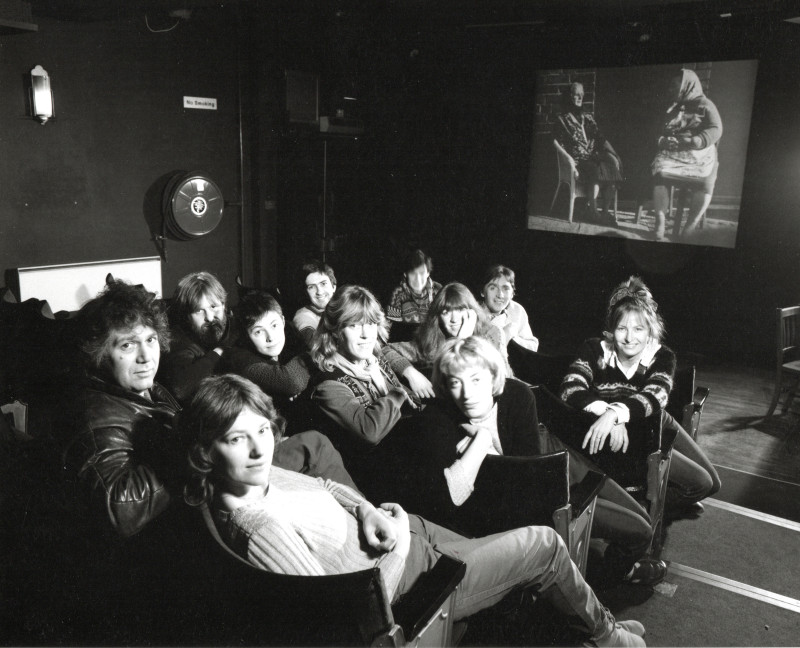About The Amber Collective
World-renowned for documenting the North East of England, the Amber Film & Photography Collective began in London in 1968. The following year they relocated to Newcastle, driven by the founding members’ vision to reconnect with the working-class culture that shaped them.

Whilst their work was initially rooted in film, photography was introduced by Sirkka-Liisa Konttinen and expanded the Collective’s capacity for intimate, nuanced storytelling. Together, Amber wove a narrative tapestry documenting the full spectrum of experience in the North East’s communities.
Driven by their dedication to sharing the stories they documented, at a time when documentary photography was rarely being shown, in 1977 Amber founded Side Gallery and Cinema in Newcastle’s Quayside. Side Gallery became the UK’s only gallery space dedicated solely to documentary photography, gaining recognition for shows from UK photographers and international talent.
By embracing the everyday stories of the working class, Amber created a cinematic and photographic language that championed respect and solidarity. Their approach fostered some of the UK’s greatest photographic talent - including Chris Killip and Tish Murtha. In 2011 Amber Films and Sirkka-Liisa Konttinen’s photographs were inscribed in the UNESCO Memory of the World register as being “of outstanding national value and importance to the United Kingdom”.
The Amber Film & Photography Collective retired in 2024. The ethos behind their collective work underpins Side's ongoing work as a cross-region documentary arts organisation, as we remain dedicated to documents of working-class lives from the North East and beyond.

AMBER COLLECTIVE TIMELINE
Amber was founded in 1968 in London by a group of film and photography students led by Murray Martin. Inspired by a vision to document working-class and marginalised communities, the group relocated to Newcastle upon Tyne in 1969. Their early work was deeply rooted in humanist documentary traditions, focusing on Northeast England’s social and industrial life.
Initially, Amber members supported their work by taking jobs in education and television, pooling their income to sustain the collective. Photography, especially through founding member Sirkka-Liisa Konttinen, became a key part of their documentary efforts. Her project, Byker (1969), captured the life of a Newcastle neighbourhood slated for demolition, setting a precedent for Amber’s deep engagement with communities.
In 1971, Amber rented workshop space on Newcastle's Quayside. As their work expanded, the group recognised the need for a dedicated space to showcase documentary photography. In 1975, they purchased property and 1977 opened Side Gallery & Cinema, an exhibition space committed to the tradition of social documentary photography.
As deindustrialisation swept across the UK, Amber shifted its focus to capturing the struggles of working-class communities. The election of Margaret Thatcher in 1979 and the subsequent decline of industries like coal, steel, and shipbuilding deeply influenced their work.
Amber's involvement in documenting the 1984 Miners' Strike was significant. The collective played a role in the Miners' Campaign Tapes, a film series that gave striking workers voice. Their engagement extended beyond documentation—Amber actively collaborated with local communities, providing a platform for their experiences and struggles.
In the 1980s, Amber played a key role in the Workshop Declaration, securing funding from Channel 4, and the British Film Institute allowed Amber to produce feature-length films such as Seacoal (1985) and In Fading Light (1989), both deeply embedded in the lived experiences of working people. Meanwhile, Side Gallery became a hub for international documentary photography, exhibiting the works of Henri Cartier-Bresson, Tish Murtha, Chris Killip, and many others.
The early 1990s brought financial challenges as Northern Arts significantly reduced Side Gallery’s funding, and Channel 4 moved away from supporting the independent Film Workshop Movement. Amber responded by focusing on international collaborations, including exchanges with East German filmmakers and Czech photographers.
Despite financial strain, Amber continued to produce films and photography projects. The closure of Easington Colliery in 1993 marked the end of the Durham coalfield, prompting Amber to document the region's post-industrial reality through community video projects like It’s the Pits.
A turning point came with a renewed focus on photographic commissions and documentary filmmaking. The Coalfield Trilogy, which included The Scar (1997), Like Father (2001), and Shooting Magpies (2005), explored the impact of industrial decline on families in Northeast England.
In the early 2000s, Side Gallery was revitalised, expanding its exhibition space and engaging with a new generation of photographers. Funding from the National Lottery and the Northern Rock Foundation supported projects like Byker Revisited (2009), in which Sirkka-Liisa Konttinen returned to document the changing cultural landscape of the Byker Wall Estate.
In 2011, Amber’s films and Sirkka-Liisa Konttinen’s photography were inscribed in UNESCO’s Memory of the World Register, cementing the AmberSide Collection as one of the UK’s most significant documentary archives.
A major milestone followed in 2015. Heritage Lottery Fund (HLF) support enabled a three-year redevelopment of Side Gallery, improving accessibility, expanding exhibition spaces, and creating a new study centre and digital archive. A Laing Art Gallery exhibition showcased the collection while Side was closed, and a large-scale digitisation project preserved 7,000 images, 2,000 minutes of film, and historic audio materials.
Amber continued its deep community engagement, launching 18 documentary projects with schools and local groups developing Amber Education’s Enquiry and Project Based Learning model.
By 2018, the AmberSide Collection had grown into an unparalleled living archive of over 20,000 photographs, 100 films, and 14TB of digital assets, offering a rich historical tapestry of working-class life in the North East.
However, shifting public arts funding brought increasing challenges, placing Amber at a crossroads as it sought long-term financial stability while maintaining its commitment to documentary storytelling and cultural preservation.
Surviving the Pandemic and Funding Cuts
The COVID-19 pandemic and subsequent funding challenges threatened Amber’s sustainability. In April 2023, the collective lost Arts Council revenue funding, leading to a significant shift in its business model.
Despite these setbacks, the public rallied behind Amber, launching a #SaveSide Crowd funder campaign, raising £67,000 in just 12 days, highlighting the gallery’s cultural importance. The outpouring of support reinforced the community’s deep connection to Amber’s work.
Recognition and Future Vision
In 2023, Side Gallery was awarded the Royal Photographic Society’s Eastlake Medal for services to photography, reaffirming its role in cultural preservation.
Amber is now working on the Heritage Funded “Transforming Amber” project, which focuses on:
Business Model Transformation – Adapting to new funding realities.
Enhanced Accessibility – Developing touring exhibitions and public digital catalogues.
Community Engagement – Expanding educational initiatives with schools and local groups.
Preservation – Digitising and cataloguing the archive for long-term sustainability.
Income Diversification – Exploring new revenue streams.
In 2024 the remaining members of the Amber Film & Photography Collective announced their retirement and sold the premises on Side in Newcastle's Quayside.
The AmberSide Collection, started by the Collective, remains secured for the region through The AmberSide trust.
Side is now a vibrant cross-region arts organisation and continues its work exploring new models, including high-profile culture partnerships, pop-up community exhibitions and digital storytelling.
Despite funding uncertainties, we remain committed to the Collective's mission, ensuring that the voices, struggles, and stories of working-class communities continue to be preserved, shared, and celebrated.

